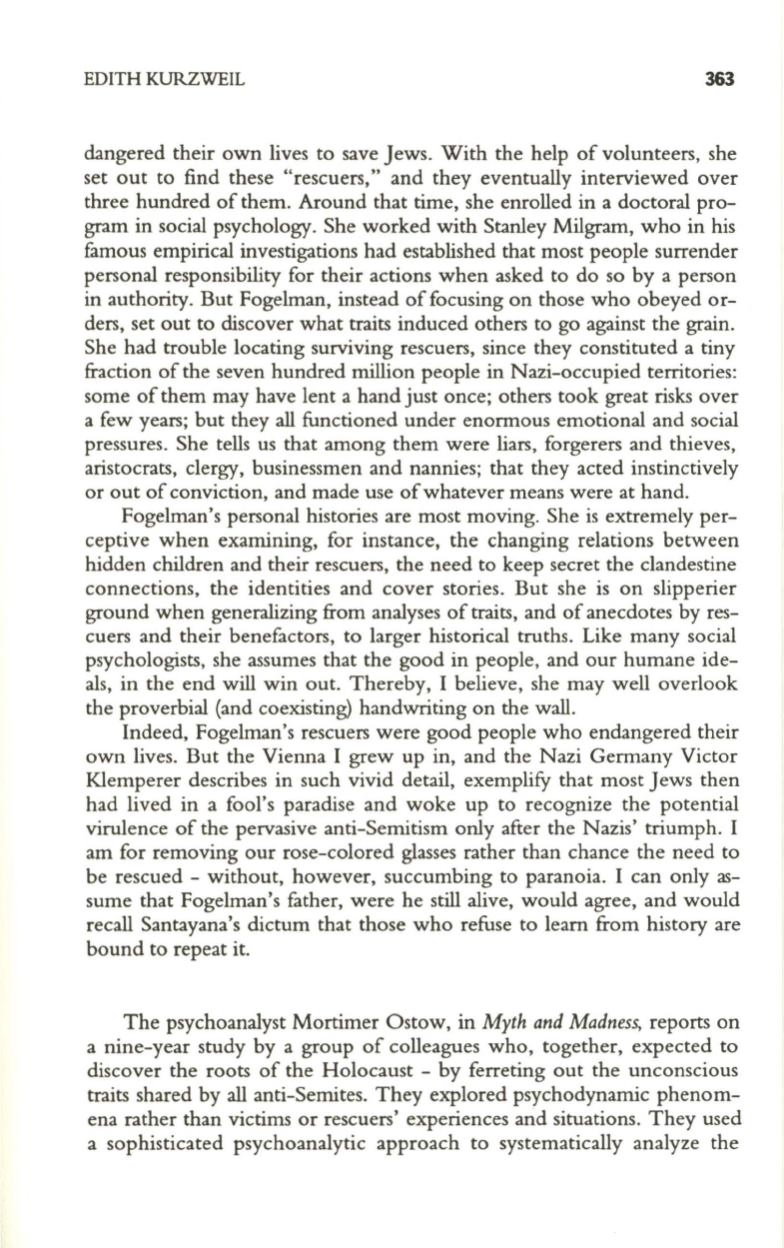
EDITH KURZWEIL
363
dangered their own lives to save Jews. With the help of volunteers, she
set out to find these "rescuers," and they eventually interviewed over
three hundred of them. Around that time, she enrolled in a doctoral pro–
gram in social psychology. She worked with Stanley Milgram, who in his
famous empirical investigations had established that most people surrender
personal responsibility for their actions when asked to do so by a person
in authority. But Fogelman, instead of focusing on those who obeyed or–
ders, set out to discover what traits induced others to go against the grain.
She had trouble locating surviving rescuers, since they constituted a tiny
fraction of the seven hundred million people in Nazi-occupied territories:
some of them may have lent a hand just once; others took great risks over
a few years; but they all functioned under enormous emotional and social
pressures. She tells us that among them were liars, forgerers and thieves,
aristocrats, clergy, businessmen and nannies; that they acted instinctively
or out of conviction, and made use ofwhatever means were at hand.
Fogelman's personal histories are most moving. She is extremely per–
ceptive when examining, for instance, the changing relations between
hidden children and their rescuers, the need to keep secret the clandestine
connections, the identities and cover stories. But she is on slipperier
ground when generalizing from analyses of traits, and of anecdotes by res–
cuers and their benefactors, to larger historical truths. Like many social
psychologists, she assumes that the good in people, and our humane ide–
als, in the end will win out. Thereby, I believe, she may well overlook
the proverbial (and coexisting) handwriting on the wall.
Indeed, Fogelman's rescuers were good people who endangered their
own lives. But the Vienna I grew up in, and the Nazi Germany Victor
Klemperer describes in such vivid detail, exemplify that most Jews then
had lived in a fool's paradise and woke up to recognize the potential
virulence of the pervasive anti-Semitism only after the Nazis' triumph. I
am for removing our rose-colored glasses rather than chance the need to
be rescued - without, however, succumbing to paranoia. I can only as–
sume that Fogelman's father, were he still alive, would agree, and would
recall Santayana's dictum that those who refuse to learn from history are
bound to repeat it.
The psychoanalyst Mortimer Ostow, in
Myth and Madness,
reports on
a nine-year study by a group of colleagues who, together, expected to
discover the roots of the Holocaust - by ferreting out the unconscious
traits shared by all anti-Semites. They explored psychodynamic phenom–
ena rather than victims or rescuers' experiences and situations. They used
a sophisticated psychoanalytic approach to systematically analyze the


